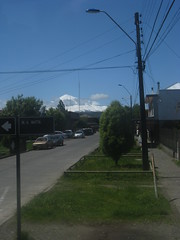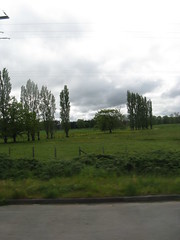The sun was out for the first time in days, and I saw the top of the cone of Villarica when I stepped outside. It was as clear as day - its whiteness rising upward from the earth's crust dramatically and close; my chest tingled and I shuddered at the thought that I was so close to death, not because the volcano was going to erupt - far from it considering it had last erupted in 1971, but more because I placed myself in a position where escape was nearly impossible if it did erupt. I've been in situations where death felt real, yet I always knew there was a way to get out of it and, that if I did die, then it wouldn't be from a lack of trying to stay alive. This was different. The chances of getting swallowed by lava or choked by toxic gases were slimmer than me getting hit by a bus, except the fear, as it always has been with me, isn't about the actual dying; it's about not being able to do anything about it while death swallowed me whole. The volcano was right there. There. I could point at and know that I was staring at something ominous and deceitful. I know this because my first two days in Pucon were spent photographing the conical hills to the north with the firm belief that, with all the clouds covering the entire area, at least one of these hills, with their rutted ribs where lava had clearly once flowed, was Villarica. It was shocking to see that the clouds had completely hidden the giant directly to the south, and I felt foolish for leaving my camera inside the hostel.
My errands took longer than expected. One of the bus stations was a fair distance away and it was difficult to find (as was a photocopy store), so when I had finished buying my ticket, eating breakfast, buying lunch, and photocopying the travel book, I had 15 minutes to pack. There was no time to even say goodbye to the friends I had made at Hostal Refugio, and that made me a little sad. Unfortunately that wasn't all that made me frown. My camera was ready to fire away when I stepped outside, but when I looked to the south and aimed my lens up where the volcano was supposed to be, all I saw was white, except it wasn't the snowpacked slopes. Clouds had covered the tip of the mountain once more. And while I could still see the base, which I hadn't even known existed to the south until today, no one wants to see a picture of a wide, snow-white base topped by a wider cloud-white top. The moment was ruined.
 I took one picture, sighed, and got on the bus. We rolled into a nearby small town on the other side of Villarica an hour later and I managed to get one picture through the glass window beyond the town's rooftops, over signs, and in between power lines. Its whiteness amazed me, even though the backside of the Volcano is not as snowed in as the Pucon side. There were green rolling hills that went higher than the lowest snow on Villarica, and yet while those rolling hills were green to the top, Villarica was nearly snow the bottom. The dead volcanoes to the north were green, and the live volcano, with magma turning inside of it, was a frozen peak. Nature, it seemed to me at that moment, was odd.
I took one picture, sighed, and got on the bus. We rolled into a nearby small town on the other side of Villarica an hour later and I managed to get one picture through the glass window beyond the town's rooftops, over signs, and in between power lines. Its whiteness amazed me, even though the backside of the Volcano is not as snowed in as the Pucon side. There were green rolling hills that went higher than the lowest snow on Villarica, and yet while those rolling hills were green to the top, Villarica was nearly snow the bottom. The dead volcanoes to the north were green, and the live volcano, with magma turning inside of it, was a frozen peak. Nature, it seemed to me at that moment, was odd.The ride to Puerto Varas was somewhat smooth. It wasn't until I got on the bus when I found out it didn't stop in town. In fact, it dropped me off at a freaking toll booth on the highway. But that turned out OK because a microbus came by a couple of minutes later and the ride into town wasn't that long anyway.
 The land between Pucon and Puerto Varas was lush, green, and fertile with vineyards, farms, and orchards dotting the rolling hills. And the individual properties were separated by those tall, thin poplars that I fell in love with from Monet's paintings in Giverny. I love poplars. I always have, and I don't know why. They're tools of society. Sure, they're wild, but they serve a delineating role set forth by humans to establish whose land belongs to whom. And they accept their role proudly with their militaristic stances. They rise straight up in the air, sky-high, and because they can grow so close to each other, it is impossible to not understand their message: this side is my owner's side and that side is your side, please respect the difference. I've always been one to break the rules. Following rules are for people who lack the courage to find their own ways. It's a harsh reality to live with all the time (and like anyone, I'm not perfectly regimented even in my own sentiments, which are frustratingly honest because even when one strives to buck trends, one is, in fact, establishing new rules to live by). So I wonder why poplars are so beautiful to me. It might be because they succeed so magnificently in their role that they literally stand out above all the other trees. It might also be because they are so in line with their role, and the fact that they stand so proudly because of their role, that they seem to be breaking the very rules that I find dear to me: they're loyal to their masters while I demand loyalty from the people I associate with. For one there is an honor for sacrificing society's riches and going alone in search of one's own riches, and for the other there is an honor for sacrificing one's own riches for the benefit of others. Maybe it's the stark difference between the two that I find beautiful. At the very least I find the beauty in respecting the poplars for what they are: graceful sentinels, breathtaking, and unwavering.
The land between Pucon and Puerto Varas was lush, green, and fertile with vineyards, farms, and orchards dotting the rolling hills. And the individual properties were separated by those tall, thin poplars that I fell in love with from Monet's paintings in Giverny. I love poplars. I always have, and I don't know why. They're tools of society. Sure, they're wild, but they serve a delineating role set forth by humans to establish whose land belongs to whom. And they accept their role proudly with their militaristic stances. They rise straight up in the air, sky-high, and because they can grow so close to each other, it is impossible to not understand their message: this side is my owner's side and that side is your side, please respect the difference. I've always been one to break the rules. Following rules are for people who lack the courage to find their own ways. It's a harsh reality to live with all the time (and like anyone, I'm not perfectly regimented even in my own sentiments, which are frustratingly honest because even when one strives to buck trends, one is, in fact, establishing new rules to live by). So I wonder why poplars are so beautiful to me. It might be because they succeed so magnificently in their role that they literally stand out above all the other trees. It might also be because they are so in line with their role, and the fact that they stand so proudly because of their role, that they seem to be breaking the very rules that I find dear to me: they're loyal to their masters while I demand loyalty from the people I associate with. For one there is an honor for sacrificing society's riches and going alone in search of one's own riches, and for the other there is an honor for sacrificing one's own riches for the benefit of others. Maybe it's the stark difference between the two that I find beautiful. At the very least I find the beauty in respecting the poplars for what they are: graceful sentinels, breathtaking, and unwavering. I arrived in Puerto Varas under heavy clouds and a thick mist. There were no views and the forecast was for more of the same the next few days, so that evening I bought a ticket for the next morning to head to Bariloche.
I arrived in Puerto Varas under heavy clouds and a thick mist. There were no views and the forecast was for more of the same the next few days, so that evening I bought a ticket for the next morning to head to Bariloche.But my short time in Puerto Varas was the most productive of my entire trip. While this has been a little bit of a vacation, it was scheduled to be more homework for deciding where to live in Chile. I got very little info about Santiago, learned that I didn't like Vina del Mar or Valparaiso, learned that Pucon wasn't for me, and that was it. I was hoping to learn where to find apartments, how to rent, how to live, and where to find the climbing community. All I had found so far was that the climbing community is closed to outsiders, that info on apartments is bad if you don't speak Spanish (yeah, I know, that's on me), and nothing else. It had been a very frustrating trip thus far.
Then I arrived at the French-speaking hostel Casa Margouya (a relief since I actually can speak French) and found three things: Americans living in Santiago (i.e. - English speakers who knew how to rent, where to look, and what living was like for Gringos, which, surprise! surprise! is something that most Chileans aren't going to know), climbers in Puerto Varas who were open to climbing without requiring advance payment, and another American who now lives in Puerto Varas who knows how to find places to live in town. SCORE! AWESOME! AWESOME! AWESOME!
I went to dinner with the Americans living in Santiago mainly because I wanted to learn more about living there. It was a productive dinner. They told me a lot and gave me some ideas and warnings. I had fish and they had these massive emapandas (a popular pastry-like dish in Chile). The size of the empanadas surprised everyone, but it was a dinner menu that we ordered from, so it wasn't completely surprising when we factored that in. The beer was good, too, but I couldn't stay out late. I had an early-morning bus to catch to Argentina, and I wanted to be up for what I was told would be a fantastic ride.

No comments:
Post a Comment
Please keep it clean and useful. Criticism is certainly OK, but crap will be deleted. Thanks!